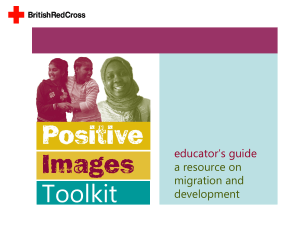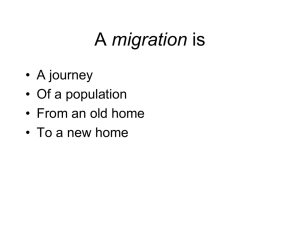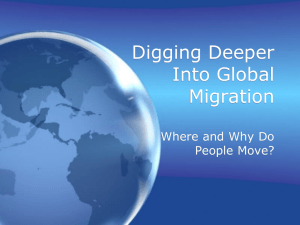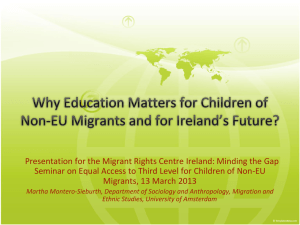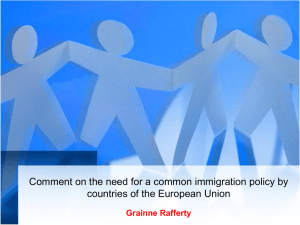Erga Migrantes Caritas Christi
advertisement
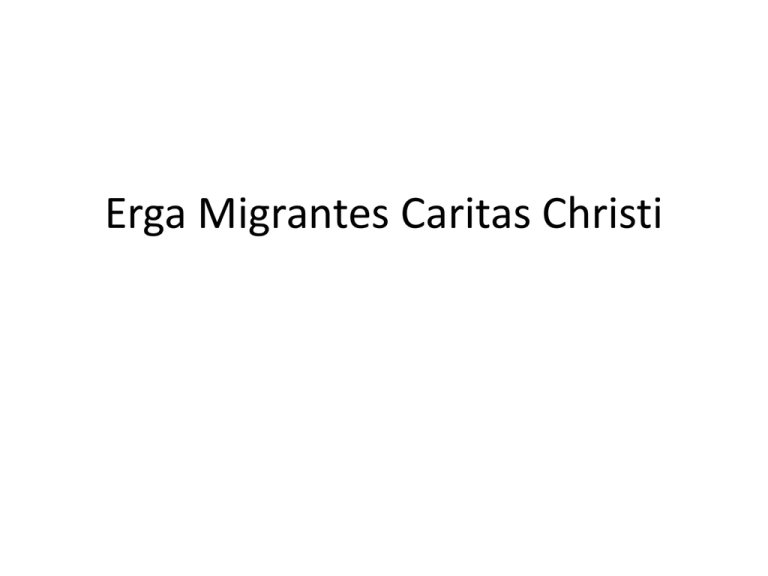
Erga Migrantes Caritas Christi Why do people migrate • When the situation in your country is such that they can no longer live according to local norms of safety, dignity, well being. What do migrants experience • They do no understand language, culture or legislation – they are vulnerable • Can easily fall victim in their new country to abuse of human rights • Easy prey for exploitation • Potential human trafficking Women and families • High proportion of women hired for domestic services • Very vulnerable job as they typically live in residence – how can they draw a line between working/non working – it is blurry • Work in entertainment industry • May end up in forced prostitution • Women’s rights need to be safeguarded • Family separation, loneliness • If married, stability for couple • If children, motherless families Mixture of Traditions, cultures & regions • Brings together all the diverse identities • Peaceful way we can live together • Example – many religious men/women as well as lay persons provide services to the poorest not only in our own regions but abroad. Church’s response • We need to share joy and hopes • We need to support newcomers in their grief and pain • We must focus our attention on human mobility – Understand their social reality – Supporting through integration to society and local church – Help them with practical as well as spiritual Brief background • • • • • • • • The impetus behind the church’s through the effort s if Pro emigratis catholicis of Blessed Giovanni Battista Scalabrini 1912 – Pope St Piux X formed first office for Migration problems 1952 – Exsul Familia – post war, Pius XII laid down guides/norms for the church, considered the Magisterial magna carta of church teaching and first official document of the Holy See – Assistance should be provided to people by priests of the same nationality/language, priest must show the same concern for them as the others in their local community – Unfortunately could not be affected by the conditions of its time 1960 – with Vatican II –with the in flux of international migration, 3rd world migration and phenomenon of refugees – Church sought the need to give a pastoral response to the many migration events – Vatican II increasing commitment to evangelization and human promotion saw need for integration not assimilation with more hands on pastoral care 1969 – Pastoralis Migratorum Cura – Of his own accord Pope Paul VI encouraged newly formed Bishops conferences to provide pastoral care for people on the move • Immigrants must be allowed to maintain cultural, social and religious practises 1970 – Pope Paul VI instituted the Pontifical commission for the pastoral care of migration & tourism 1989 – Became the Pastoral Care of Migrants & Iterant people (people who travel place to place, no home) who role was to animate and offer pastoral encouragement to individual conferences. 2005 – Erga Migrantes Caritas Christi – instruction which turned into a structural component. Social, cultural, political, religious, economic and pastoral urgency. Meant to be an ecclesial response to the pastoral needs of migrants. Making migration an occasion of dialogue & mission in the context of new evangelization. Attention to Latin and Eastern churches. Summary “the Ecclesial Community is asked to be more and more conscious of its universal mission in the world and in history before God and mankind, confident that migrants will in the end be instruments of unity and peace in a world that is ever more united and solidarity.” http://www.ewtn.com/library/curia/pcmiprer.htm Migrants in our Economy • Economic – bring professional and technical skills and work alongside regular citizens, many times address current gaps in our labour forces (ie: nurses) • Foreign workers – contribute to our economy providing service focused labour (nanny, caregiver, farms, service roles) and contribute to their home country • We must protect them and ensure they are not treated as just “manpower” – Treatment must be just and equitable – May become a part of larger communities or labour unions to support them – Need to ensure the do no become victims of human trafficking (new age slavery) Rights of families • Family reunification – must be a consideration • Support newcomers so they can keep their families unified and be in a position to educate their children (faith and regular schooling) • Equal rights and opportunities – work, wages, voting • Ensure we are participating in civil society to ensure the rights of the migrants and their families are recognized and protected • Recognize the “International convention on the protection of the rights of all migrants workers” Migration & Dialogue • Pastors and lay faithful must understand the importance of language, mentality , culture and religious traditions of our Catholic migrants • Understand their church of origin and support a collaboration between the two churches • Commit to assigning specific members to the spiritual care of migrants (ie: religious) Closing • Migration can make Christians “aware of them and always be a sign of fraternity & communion with the world” – Respect the differences – Practise solidarity – Missionary vocation • Pastoral lines of the Magisterium • 27. Not only the canonical norms, but also a careful study of the documents and directives on migration so far issued by the Church clearly brings to light certain important theological and pastoral findings that have been acquired. These are: the central position of the human person and the defence of the rights of migrants, both men and women, and their children; the ecclesial and missionary dimension of migration; the reappraisal of the apostolate of the laity; the value of cultures in the work of evangelisation; the protection and appreciation of minority groups in the Church; the importance of dialogue both inside and outside the Church; and the specific contribution of emigration to world peace. These documents also illustrate the pastoral dimension of work for migrants. In fact all should find “their homeland”26 in the Church, for the Church is the mystery of God among men, the mystery of love shown by the Only-Begotten Son, especially in His death and resurrection, so that all “may have life, and have it to the full” (Jn 10,10), so that all may find strength to overcome every division and act in such a way that differences do not lead to rifts but communion by welcoming others in their legitimate diversity. • http://www.vatican.va/roman_curia/pontifical_councils/migrants/documents/rc_pc_migrants_doc_20040 514_erga-migrantes-caritas-christi_en.html#Canonical norms



